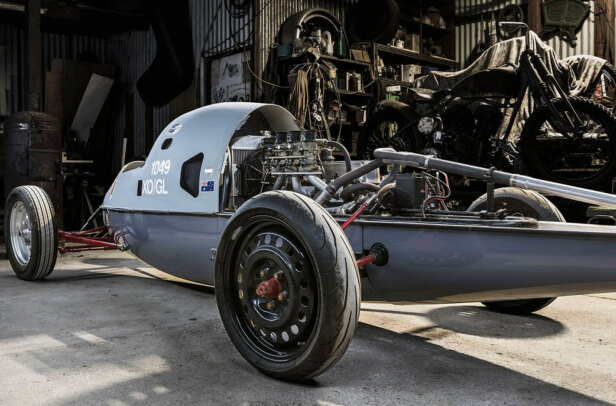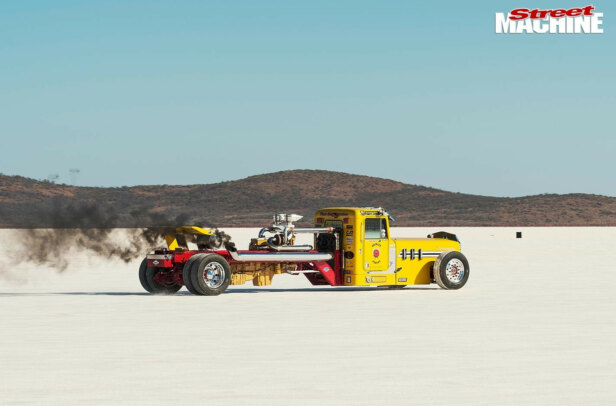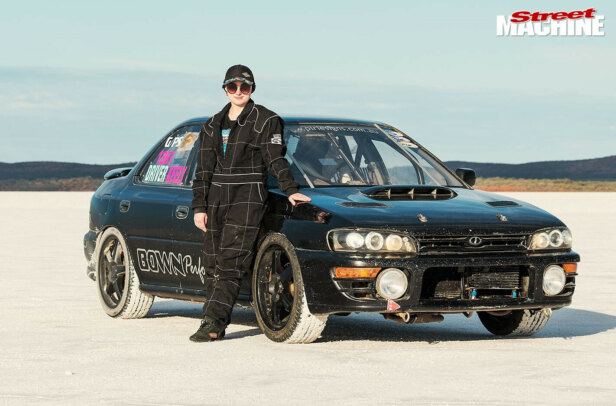THEY come from all over the country, in all kinds of vehicles, to answer one simple question: How fast can I go? Welcome to the salt flats of Lake Gairdner, South Australia – home of the annual land speed racing extravaganza, Speed Week. The lake’s seemingly endless salty vista is surreal to say the least, but it’s also exquisitely flat, making it the fastest race track in the country – perfect for testing yourself and your machine against the gods of speed.
There’s no prize money at Speed Week, just racer versus machine versus the salt lake. Building a salt racer can take decades, and for some competitors the drive to the lake is over 30 hours, but they do it all for the simple joy of competing and the possibility of bagging a record.
There’s an undeniable romance to land speed racing that pulls in competitors and fans year after year. Some call it salt fever – a near-mystical energy that’s as close as motorsport can get to a spiritual experience. Outsiders may question the sanity of building a machine that you can only race in one place once a year, but for those in the know, it all makes sense. After the 2020 running of Speed Week was cancelled due to COVID-19, the energy on the lake for this year’s event was high. The coming together of the land-speed community felt like life had found some normality again, and you couldn’t wipe the smiles of people’s faces. The lake surface for Monday’s first day of racing was perfect and the weather was tipped to only get better.
Unfortunately, an unscripted storm came through Wednesday morning that saw the lake very quickly covered in two inches of water. When the sun came out, the surface became a mirror, though on the plus side, it meant Wednesday’s sunset was hypnotic. Needless to say though, racing was over for the day.
Participants awoke Thursday morning to standing water and resigned themselves to a racing-free day – other than bench racing, of course. Come Friday, there was still too much water on the surface and the event came to an official premature end.
Even so, in just two days of racing, 226 entrants ran 492 passes over the two tracks, and 40 records were set – one of the greatest starts to any Speed Week. All were left wondering what might have been if the rain hadn’t hit. Yet even with Mother Nature spoiling the fun this time around, you can bet most entrants will be back next year. Land speed racing is addictive. A special shout-out should go to the hard-working committee of the Dry Lakes Racers Australia, which oversees the running of Speed Week. Without the likes of club president Greg Wapling, secretary Carol Hadfield, race director Steve ‘Animal’ Charlton and a troupe of conscientious volunteers, the event could not continue.
If you’re keen to have a crack at Speed Week yourself or just come along to see what the fuss is about, you’ll find plenty of info at dlra.org.au.
HOT ROD TIME MACHINE
NOVOCASTRIAN Bob Bowman is one of Australia’s hot rodding stalwarts, and first came to the salt 29 years ago. Like many gearheads confronting the limitlessness of the great white dyno for the first time, he was bitten hard by salt fever. Arriving home with a head full of ideas, he was soon piecing together what has become the longest-running hot rod at Lake Gairdner: this 1927 Ford roadster.
The car was built with what was available at home, and runs a 1969 Ford Boss motor with high-ported 4V heads, Jerico ’box and a Halibrand quick-change diff.
Over the past 26 years, the roadster has held two records, with a top speed of 194mph. For Bob and the rest of the team, collectively known as The Stans, Speed Week is about staying in the game: “It doesn’t matter if you win or lose as long as you turn up,” he said.
COUPE DE THRILL
ANDREW Hutchinson’s genuine 1930 Ford coupe was one of the most beautiful cars on the lake – a stunning example of a 1950s street rod. The project started 25 years ago when Andrew picked up the 1930 Canadian body for $2K, and he’s done most of the work on the car himself, with a little help from friends.
The 396 short motor has been with Andrew since he was 19, but it needed some love from engine builder Matt Lagoon before it was ready to race. A Muncie ’box out of a ’67 Camaro and a banjo diff round out the driveline.
Four years ago, the decision was made to prep the coupe to race at Speed Week. In went race seats and a rollcage, but as with most builds, this one came down to the wire.
Speed Week 2021 was the most Andrew had ever driven the car, and with only one pass under his belt, it was good to see the coupe run 113mph.
Will he be back next year? “Absolutely,” he reckoned, but not before pulling out the ’cage to register the coupe for the road.
’PLANE SAILING
THIS 1936 Australian-delivered Hudson Terraplane is the love child of Gus Cooper, John Harvey and Darren Banks, who all hail from Perth. This year was the boys’ fourth time at the salt but their first with a new set-up for the Hudson: a 430-cube big-block running methanol and topped by an 8/71 Roots blower. On 6psi of boost, the combo is good for 1050hp.
Back in 2019, the Terraplane was darting from side to side down the track. Slowing the steering ratio down with the addition of longer steering arms has ironed out the bugs.
The car has already run 208mph with Gus at the wheel, earning him a coveted 200mph Club red cap. This year, the aim was for the rest of the team to break the 200mph barrier. Darren qualified for a record on Tuesday with a 200mph pass with change, before rain put an end to the week. Cruelly, John never had his chance to drive. But the boys will be back next year, as they feel the car is good for 250mph.
GIRL POWER
ONE of two all-girl teams this year, Gemma Dunn and Rachelle Splatt make quite the power couple. Gemma is an Olympic shooter and a 234mph record holder on the lake, while Top Fuel drag racer Rachelle was the first woman in the world to run over 300mph on the strip.
Over the years, the Dunn family lakester has etched out its own legend, having taken multiple records over 200mph, with a fastest pass of 251mph with Gemma’s dad Mark at the wheel.
In the COVID off-season, the car was completely stripped down and rebuilt. One of the most important developments was the ability to quickly swap between B and C engines. On the outside, the engines are identical. Each has its own manifold, carby and clutch set-up, but the dry sump, alternator and water pump stay in the car to be used with either configuration. Gemma was the fastest woman of the 2021 event with a 224mph pass, while Rachelle qualified for a class record of 208mph before the rain.
CHILD’S PLAY
THIS gorgeous lakester was home-built over the course of last year by Toowoomba’s Ron Gray with his daughters Emily (14) and Kylie, aka ‘Bone’ (11). One week of each school holiday and every weekend was dedicated to the task, and in 12 months the car was ready to race. The girls did the fibreglass bodywork, including all the prep for paint, as well as bending the tube for the rollcage. The lakester runs a 2013 Kawasaki Ninja engine and gearbox.
To keep the highly competitive sisters on an even playing field, they ran in different classes. There was also a bet on the table that if either of the girls ran over 100mph they could cut Dad’s hair (Ron was sporting a fetching COVID mullet). Sadly, with the weather ending race week early, the mullet was safe. At stumps, both girls had qualified for a record, with Kylie running 77.070mph in K/FL and Emily 76.176mph in K/GL.
West Australian Rob Waters set out to build a truck for the salt out of bits he had lying around, which is not too hard to do if you run a trucking business and race team. All up, the 9.5m-long W-series Kenworth known as ‘The Prospector’ owes him about $5K – and quite a few cartons in labour. With the truck pumping out 2450hp with 70psi of boost through a massive turbo, Rob came home with a record of 141.314mph.
Norm Hardinge has campaigned his iconic ’34 roadster every year Speed Week has run since 2000. Along the way, he’s taken home five records and joined the 200mph Club. The car currently runs a Chev 572 crate motor good for 730hp, with a 194.917mph record to its name. This year, the diff let go after a couple of 160mph shakedown runs, and they couldn’t fix it before the rain came.
As Darryn Weeks approached the two-mile mark on his first pass Tuesday morning in the 1993 VP Commodore he shares with Tom Noack, it all went wrong at 195mph. “The car felt fairly settled before it just let go,” he said. “After three spins, she sort of straightened up before going around another three times.” Rain put paid to any further attempts, but Tom had already set a new C/GCC record of 209.919mph on Monday.
By 3pm on the first day of racing, Blake Clare had set a class record of 205.5mph and joined the 200mph Club in the Clare Brothers’ MX-5. Up front there’s a 4.0L Toyota V8, force-fed by a Harrop supercharger and coupled with a twin-plane intercooler. Next year will see the return of Blake’s brother Trent behind the wheel, after suffering a near-fatal crash in 2015.
Ten-year-old Banjo McGrath was the youngest racer at Speed Week this year. Having ridden motorbikes since he was four, Banjo was all set to pilot a 1970 Benelli 50cc Fireball, but at the last moment, mechanical gremlins kept the Benelli quiet. In the end, the community came to the rescue with a donor bike, giving Banjo the chance to license.
73-year-old Noel Heenan has an extensive motorsport background, having raced motocross and campaigned an HQ at the Calder Park Thunderdome in the 80s. Now he pilots this Australian-built 1997 Thunderbird NASCAR at the salt. The team of Noel, wife Victoria, Darron Stanton and Leo Darveniza spent Monday and Tuesday running through their licensing passes to 150mph, and they’ll be back next year to chase 200mph.
Brisbane’s Matthew Saunders has run this 1939 Fiat Topolino with a Holden 253/single-rail four-speed driveline at the salt since 2005. This year he shared driving duties with his daughter, Heidi, who first came to Speed Week as a spectator in 2003, aged 11. They each managed two drives before the rain hit.
The John Dent bellytank took home the fastest pass of the meet on a qualifying run of 275mph, with Eddie Zeller behind the wheel. However, the rain brought an end to any chance of the car taking a record. The ’tank is powered by an 8/71-blown 542ci big-block slurping methanol.




Comments